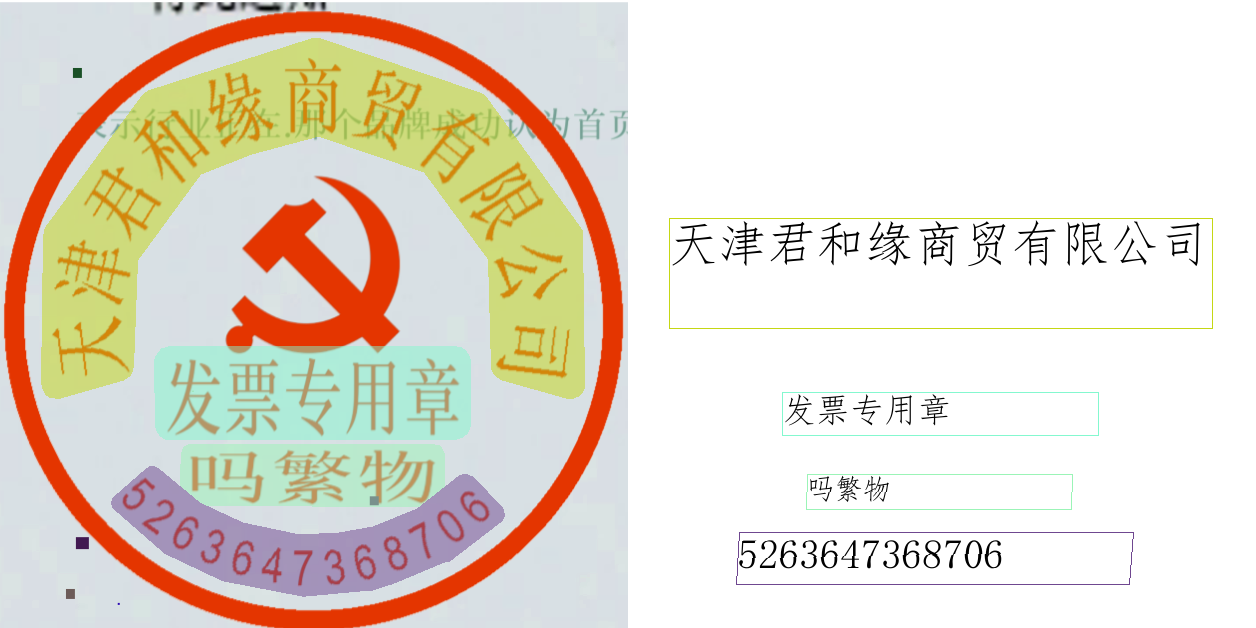🚀 PP-OCRv4_server_seal_det
PP-OCRv4's server-side seal text detection model offers high accuracy and is suitable for deployment on well - equipped servers.
🚀 Quick Start
✨ Features
The server-side seal text detection model of PP-OCRv4 has higher accuracy. The key accuracy metric Hmean on the PaddleX Custom Test Dataset (containing 500 images of circular stamps) is 98.21%.
| Property |
Details |
| Model Type |
PP-OCRv4_server_seal_det |
| Training Data |
PaddleX Custom Test Dataset, Containing 500 Images of Circular Stamps |
📦 Installation
- PaddlePaddle
Please refer to the following commands to install PaddlePaddle using pip:
python -m pip install paddlepaddle-gpu==3.0.0 -i https://www.paddlepaddle.org.cn/packages/stable/cu118/
python -m pip install paddlepaddle-gpu==3.0.0 -i https://www.paddlepaddle.org.cn/packages/stable/cu126/
python -m pip install paddlepaddle==3.0.0 -i https://www.paddlepaddle.org.cn/packages/stable/cpu/
For details about PaddlePaddle installation, please refer to the PaddlePaddle official website.
- PaddleOCR
Install the latest version of the PaddleOCR inference package from PyPI:
python -m pip install paddleocr
💻 Usage Examples
Basic Usage
You can quickly experience the functionality with a single command:
paddleocr seal_text_detection \
--model_name PP-OCRv4_server_seal_det \
-i https://cdn-uploads.huggingface.co/production/uploads/63d7b8ee07cd1aa3c49a2026/k02u35x60XZmaL9hzeQ0T.png
You can also integrate the model inference of the seal text detection module into your project. Before running the following code, please download the sample image to your local machine.
from paddleocr import SealTextDetection
model = SealTextDetection(model_name="PP-OCRv4_server_seal_det")
output = model.predict(input="k02u35x60XZmaL9hzeQ0T.png", batch_size=1)
for res in output:
res.print()
res.save_to_img(save_path="./output/")
res.save_to_json(save_path="./output/res.json")
After running, the obtained result is as follows:
{'res': {'input_path': 'k02u35x60XZmaL9hzeQ0T.png', 'page_index': None, 'dt_polys': [array([[165, 469],
...,
[161, 466]]), array([[444, 444],
...,
[441, 443]]), array([[466, 346],
...,
[462, 345]]), array([[324, 38],
...,
[320, 37]])], 'dt_scores': [0.989991263358307, 0.9934761181445114, 0.9916670610495292, 0.9857514344934838]}}
The visualized image is as follows:

For details about usage command and descriptions of parameters, please refer to the Document.
Advanced Usage
The ability of a single model is limited. But the pipeline consists of several models can provide more capacity to resolve difficult problems in real-world scenarios.
Seal Text Recognition Pipeline
Seal text recognition is a technology that automatically extracts and recognizes the content of seals from documents or images. The recognition of seal text is part of document processing and has many applications in various scenarios, such as contract comparison, warehouse entry and exit review, and invoice reimbursement review. And there are 5 modules in the pipeline:
- Seal Text Detection Module
- Text Recognition Module
- Layout Detection Module (Optional)
- Document Image Orientation Classification Module (Optional)
- Text Image Unwarping Module (Optional)
Run a single command to quickly experience the OCR pipeline:
paddleocr seal_recognition -i https://cdn-uploads.huggingface.co/production/uploads/63d7b8ee07cd1aa3c49a2026/k02u35x60XZmaL9hzeQ0T.png \
--seal_text_detection_model_name PP-OCRv4_server_seal_det \
--use_doc_orientation_classify False \
--use_doc_unwarping False \
--save_path ./output \
--device gpu:0
Results are printed to the terminal:
{'res': {'input_path': '/root/.paddlex/predict_input/k02u35x60XZmaL9hzeQ0T.png', 'model_settings': {'use_doc_preprocessor': True, 'use_layout_detection': True}, 'doc_preprocessor_res': {'input_path': None, 'page_index': None, 'model_settings': {'use_doc_orientation_classify': False, 'use_doc_unwarping': False}, 'angle': -1}, 'layout_det_res': {'input_path': None, 'page_index': None, 'boxes': [{'cls_id': 16, 'label': 'seal', 'score': 0.9755404591560364, 'coordinate': [6.19458, 0.17910767, 634.38385, 628.8424]}]}, 'seal_res_list': [{'input_path': None, 'page_index': None, 'model_settings': {'use_doc_preprocessor': False, 'use_textline_orientation': False}, 'dt_polys': [array([[320, 38],
...,
[315, 38]]), array([[461, 347],
...,
[456, 346]]), array([[439, 445],
...,
[434, 444]]), array([[158, 468],
...,
[154, 466]])], 'text_det_params': {'limit_side_len': 736, 'limit_type': 'min', 'thresh': 0.2, 'max_side_limit': 4000, 'box_thresh': 0.6, 'unclip_ratio': 0.5}, 'text_type': 'seal', 'textline_orientation_angles': array([-1, ..., -1]), 'text_rec_score_thresh': 0, 'rec_texts': ['天津君和缘商贸有限公司', '发票专用章', '吗繁物', '5263647368706'], 'rec_scores': array([0.99340463, ..., 0.9916274 ]), 'rec_polys': [array([[320, 38],
...,
[315, 38]]), array([[461, 347],
...,
[456, 346]]), array([[439, 445],
...,
[434, 444]]), array([[158, 468],
...,
[154, 466]])], 'rec_boxes': array([], dtype=float64)}]}}
If save_path is specified, the visualization results will be saved under save_path. The visualization output is shown below:

The command-line method is for quick experience. For project integration, also only a few codes are needed as well:
from paddleocr import PaddleOCR
ocr = PaddleOCR(
seal_text_detection_model_name="PP-OCRv4_server_seal_det",
use_doc_orientation_classify=False,
use_doc_unwarping=False,
device="gpu:0",
)
result = ocr.predict("https://cdn-uploads.huggingface.co/production/uploads/63d7b8ee07cd1aa3c49a2026/k02u35x60XZmaL9hzeQ0T.png")
for res in result:
res.print()
res.save_to_img("output")
res.save_to_json("output")
The default model used in pipeline is PP-OCRv4_server_seal_det. For details about usage command and descriptions of parameters, please refer to the Document.
📚 Documentation
📄 License
This project is licensed under the Apache-2.0 license.


 Transformers
Transformers